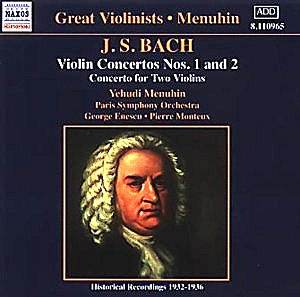The hero of the Double Concerto is in some ways Pierre
Monteux. As we saw in the recent reissue of his Orfeo ed Euridice
(BMG 09026 63534 2; ruined, alas, by Risë Stevensís old battleaxe
of an Orfeo), his natural tendency to clear textures, light basses,
not too much legato and springy rhythms, produced results in older music
which are still acceptable today. The modern listener will note the
lack of a continuo instrument, but since in 1932 that would probably
have meant a piano, maybe things are better as they are. 16-year-old
Menuhin and his revered teacher fit in with the generally clean-limbed
approach (the Largo ma non tanto is less romantic than some performers
give us even today).
Unfortunately the same orchestra under Enescu give
us Bach as he was wont to be given those days. Fine musician as he was,
he is unable to do anything about the heavy basses, the slogging rhythms
and the dense textures deriving from too much legato.
Still, the main point here is Menuhin, and here I have
to register a certain surprise. Even at this relatively tender age,
the ability of Menuhinís tone, without any perhaps ostensible qualities
of brilliance, depth, warmth or whatever, somehow to "ennoble"
the classics with its simple yet "spiritual" naturalness,
had already been noted by his contemporaries, yet all I hear in these
performances is well-schooled playing. It is good that he had already
evolved a style which would still be heard as acceptable Bach playing
to the end of his career, but there is no doubt that in the Ď50s and
Ď60s (before nerves began to compromise his technical delivery) his
playing revealed much more fully that spirituality which is at the root
of his legend.
As a good modern instruments version of the three concertos,
Menuhinís Bath Festival recordings are still in the running. More than
a myth, these first recordings simply provide a pleasant snapshot of
his career at that moment.
Good transfers by Ward Marston, informative notes by
Tully Potter. Among other things, Potter tells us that Adolf Busch was
first approached as Menuhinís partner for the Double Concerto. He declined,
saying that he always put artistic considerations before commercial
ones and it was too early for Menuhin to record the work. This is the
paradox of recorded music. We can hear that Busch was right; but how
nice that we can hear this for ourselves.
Christopher Howell



